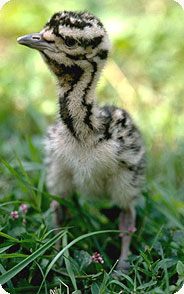Zoo Receives Award for Efforts in Breeding Kori Bustards
/https://tf-cmsv2-smithsonianmag-media.s3.amazonaws.com/filer/2011052011062120080708-347JC_-204x300.jpg)
The National Zoo is home to many rare and unusual birds: cassowaries, emus, brown kiwis, flamingos and even peacocks all flap their wings in the Zoo's bird habitat. But none of these are quite so peculiar as the world's largest flying bird, the kori bustard.
Male kori bustards weigh up to 40 pounds. As one might imagine, lugging that much weight around in mid-air is an onerous excercise. Thankfully, their omnivorous diet allows them to ground forage on the smorgasbord offered up by the African savannah where they live. They feed on small mammals, lizards, berries, acacia tree "gum" until their stomachs are content. Unless being pursued by a predator, kori bustards rarely leave the ground.
Females are only about half the size of males, but the males need all the help they can get in the competition to lure females to their side. During courtship, males puff out their esophagus and flash their white underfeathers at the females passing by in hopes that one will see something she likes.
Though fairly prevalent on the Serengeti plains, kori bustard populations have been dwindling in several other African locations due to habitat loss, poaching and because the animals are slow to reproduce. By breeding kori bustards in captivity, zoos around the world are hoping to learn more about how these birds might be preserved in the wild.
Since 1997, the Zoo successfully bred almost 50 kori bustards, more than any other accredited facility.

Last week in recognition of that success, the National Zoo's kori bustard research team received the Edward H. Bean Award, presented by the Association of Zoos and Aquariums (or AZA, of which the National Zoo is a member). The award celebrates the team's success breeding this increasingly rare African species.
"I am proud that our dedication to science and public education is making such a significant contribution to the local and international conservation of these birds," said the Zoo's director Dennis Kelly, in a report.
The National Zoo is also spearheading efforts to preserve the bird by better understanding its habits and behaviors: in addition to studying them at the Washington, DC and Front Royal, Va. campuses, Zoo veterinarians have also conducted two different studies in Kenya exploring the health and feeding ecology of kori bustards in the wild.
The Zoo currently has six kori bustards on view in two separate yards, and they are expecting a new male to come in next week. Though not currently on display, the Zoo also bred a group of four kori bustard chicks earlier this year, which are slated to go to Germany next spring.
/https://tf-cmsv2-smithsonianmag-media.s3.amazonaws.com/accounts/headshot/jess-righthand-240.jpg)
/https://tf-cmsv2-smithsonianmag-media.s3.amazonaws.com/accounts/headshot/jess-righthand-240.jpg)